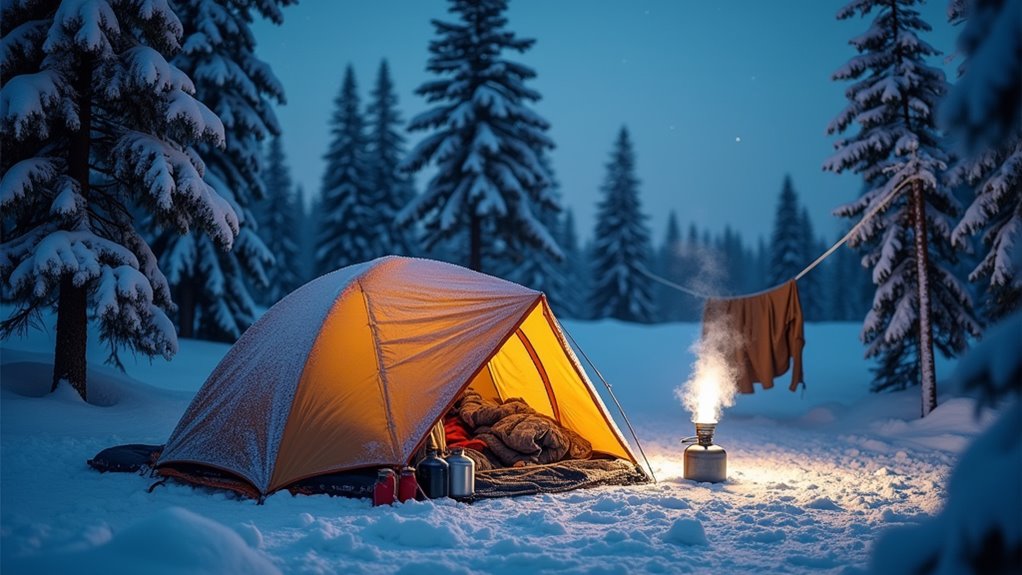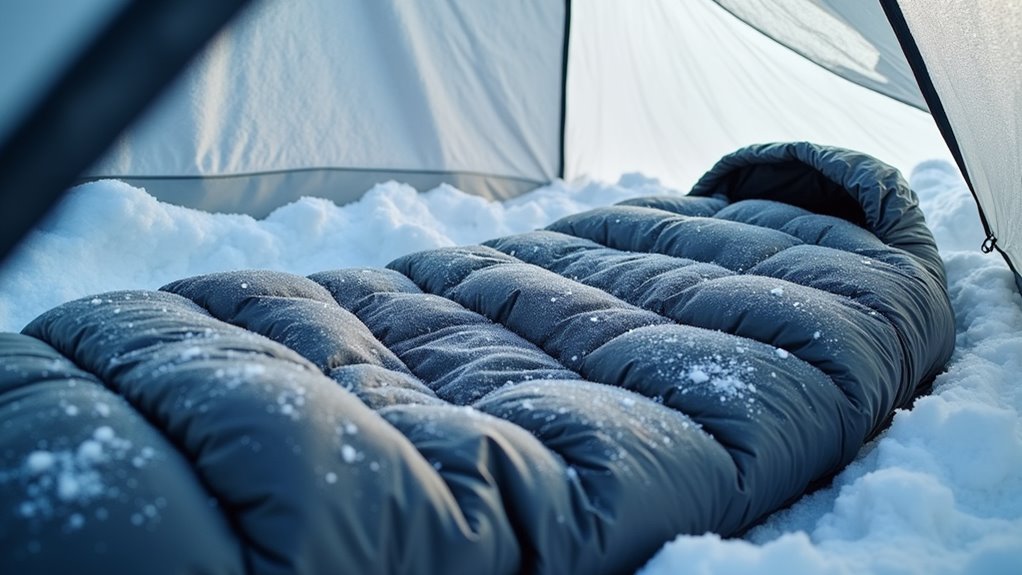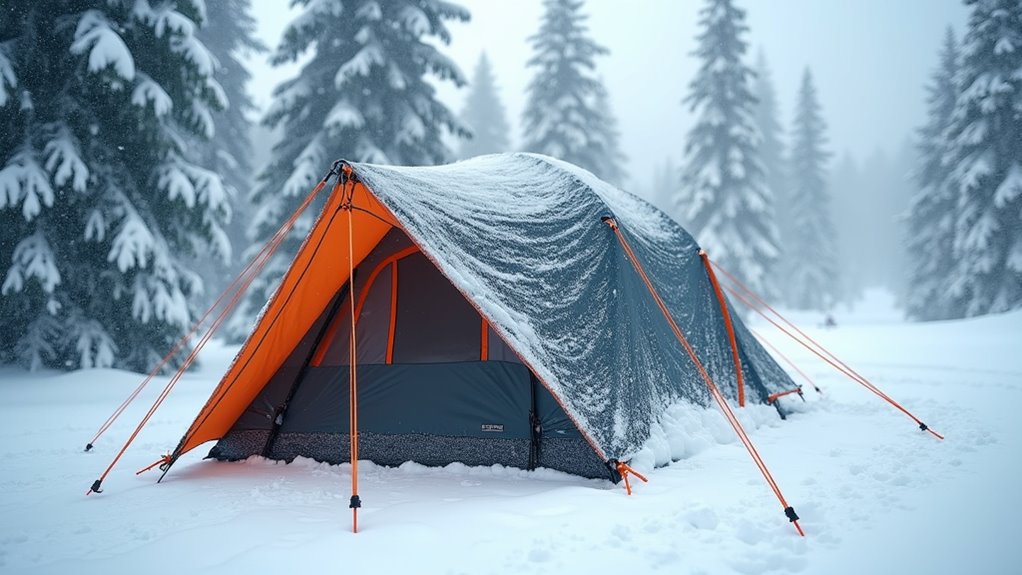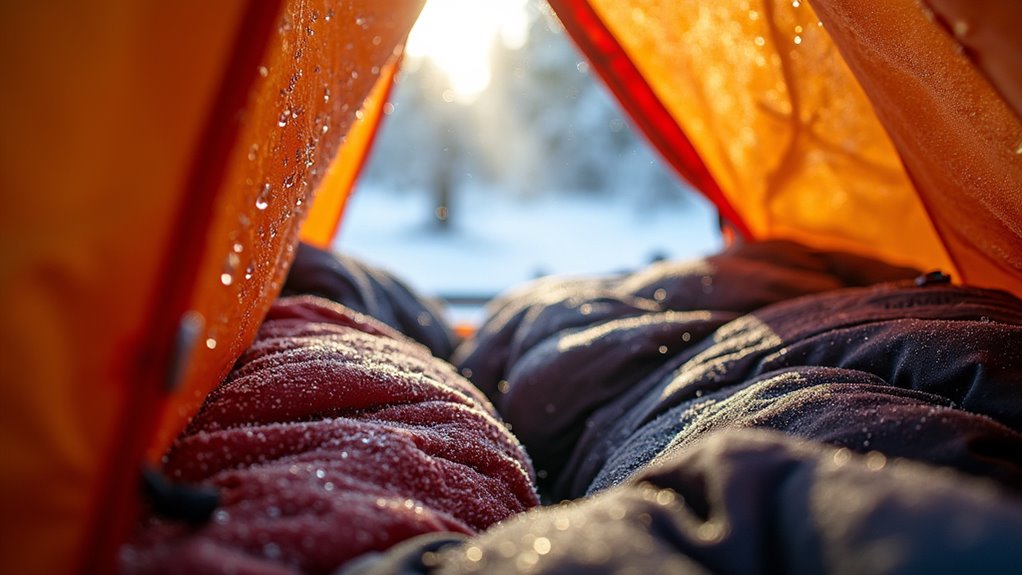Physical Address
304 North Cardinal St.
Dorchester Center, MA 02124
Physical Address
304 North Cardinal St.
Dorchester Center, MA 02124

Keep yourself alive in freezing temperatures with these 7 essential cold-weather camping tips that could mean the difference between comfort and catastrophe.
You’ve probably heard those horror stories about campers who underestimated winter’s bite and paid dearly for it. The truth is, cold-weather camping doesn’t have to be a survival nightmare—it can actually be one of your most rewarding outdoor experiences. But here’s the catch: there’s almost zero margin for error when temperatures drop below freezing. Make the wrong gear choice or skip a vital step, and you’ll quickly find yourself in serious trouble.

When temperatures plummet below freezing, your sleeping system becomes your lifeline against hypothermia and frostbite. You’ll need a sleeping bag rated at least 10-15 degrees below the expected nighttime low. Don’t skimp here – your life depends on it.
Layer your sleeping system strategically. Use a closed-cell foam pad beneath an insulated sleeping pad to create a barrier between you and the frozen ground. Ground contact steals body heat faster than cold air.
Choose a mummy-style bag for maximum warmth retention, and consider a sleeping bag liner for extra insulation. Keep tomorrow’s clothes inside your bag – they’ll stay warm and ready to wear.
Test your complete system before heading out. You can’t afford surprises when it’s -20°F outside.
Research the top-rated winter sleeping bags designed specifically for extreme cold conditions to ensure you’re investing in proven cold-weather performance.
While your sleeping system keeps you warm at night, proper clothing layers protect you during active hours in freezing conditions. Start with a moisture-wicking base layer made from merino wool or synthetic materials—never cotton, which stays wet and steals your body heat.
Cotton kills in cold conditions—it retains moisture and strips away precious body heat when you need it most.
Add an insulating middle layer like fleece or down that traps warm air while allowing moisture to escape. Top it off with a waterproof, breathable shell that blocks wind and precipitation.
You’ll adjust these layers throughout the day as your activity level changes. Remove your insulating layer before strenuous activities to prevent overheating and sweating. Put it back on during rest breaks or when temperatures drop.
Don’t forget warm socks, insulated boots, waterproof gloves, and a hat that covers your ears. This three layer system provides maximum versatility for varying weather conditions and activity levels during cold-weather adventures.

Your shelter choice and setup can make the difference between a comfortable night and a miserable ordeal in freezing temperatures. Choose a four-season tent designed for winter conditions – it’ll handle wind and snow loads better than three-season models. Look for steep walls that shed snow effectively and vestibules for gear storage.
Site selection matters tremendously. Avoid valleys where cold air settles, and don’t camp directly under snow-laden branches. Find natural windbreaks like rock formations or dense trees, but ensure adequate ventilation to prevent condensation buildup.
Set up before darkness falls and temperatures drop further. Pack snow firmly under your tent floor for insulation, and angle your entrance away from prevailing winds. You’ll sleep warmer and wake up refreshed. Remember that proper gear storage in your vestibule keeps essential items accessible while protecting them from the elements.
How much extra food should you pack for cold-weather camping? Plan for 4,000-5,000 calories per day – roughly double your normal intake. Your body burns markedly more energy maintaining core temperature in frigid conditions.
Pack calorie-dense foods that won’t freeze solid. Nuts, dried fruits, energy bars, and chocolate provide quick fuel.
Hot meals matter too – they warm you from inside while delivering essential calories. Oatmeal with nuts, pasta with olive oil, and hearty soups work perfectly.
Don’t skip meals or skimp on portions. Eating regularly keeps your internal furnace burning strong.
Keep snacks accessible in your jacket pockets for quick energy boosts throughout the day.
Stay hydrated with warm beverages like tea or hot chocolate. Dehydration reduces your body’s ability to regulate temperature effectively.
If you’re planning a cold-weather fishing expedition, consider whether renting or buying a boat makes more sense for your specific trip needs and budget.

Condensation becomes your silent enemy in cold-weather camping, turning dry gear into soggy, heat-robbing equipment. When warm, moist air from your breathing and body heat meets cold surfaces, water droplets form inside your tent and sleeping bag.
You’ll need proactive strategies to combat this moisture buildup:
Combat moisture buildup with proactive strategies before condensation transforms your essential gear into soggy, heat-stealing equipment that compromises your winter camping safety.
Don’t let moisture sabotage your warmth. Managing condensation keeps your gear dry and maintains its insulating properties throughout your winter adventure. Your choice of outdoor clothing materials also plays a crucial role in moisture management, as synthetic and merino wool fabrics wick sweat away from your body better than cotton.
While snow and wet conditions can make fire-building feel impossible, you’ll find success with the right techniques and preparation. Start by creating a dry foundation using logs or stones to elevate your fire off the snow.
Gather tinder, kindling, and fuel wood before lighting anything – wet conditions demand extra materials since some won’t catch immediately.
Focus on finding the driest wood available, often dead branches still attached to trees. Split larger pieces to access dry interior wood. Birch bark works exceptionally well as tinder in wet conditions due to its natural oils.
Build a platform fire or lean-to structure to protect flames from moisture. Keep extra tinder and kindling dry in waterproof containers.
Once established, maintain your fire consistently – restarting becomes considerably harder in cold, wet conditions. Pack essential camping utensils in waterproof bags to ensure you have dry tools available for outdoor cooking once your fire is ready.

Cold-weather injuries can escalate from minor discomfort to life-threatening emergencies faster than you might expect, making early recognition your most critical skill. Stay vigilant for these warning signs and know how to respond quickly.
Recognizing cold-weather injury symptoms early can mean the difference between minor treatment and a life-threatening emergency.
Key cold-weather injuries to watch for:
For hypothermia, get the person warm and dry immediately. Remove wet clothing and provide insulation.
With frostbite, don’t rub affected areas—rewarm gradually with body heat. Seek medical attention for severe cases.
Prevention through proper clothing and awareness beats treatment every time.
These risks become even more critical when engaging in activities like glacier climbing, where extreme cold and remote locations can make emergency treatment difficult.
You’ve now got the tools to conquer winter’s bite like a seasoned arctic explorer. Don’t let Jack Frost catch you unprepared—your layering system, shelter skills, and fire-building prowess will keep you warm when the mercury drops. Remember, even experienced mountaineers started as beginners, so practice these techniques before heading into the backcountry. Stay vigilant for cold injuries, keep your gear dry, and you’ll turn winter’s harsh embrace into an unforgettable adventure.